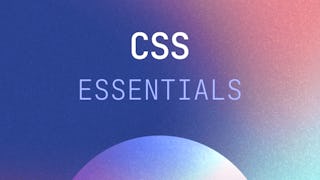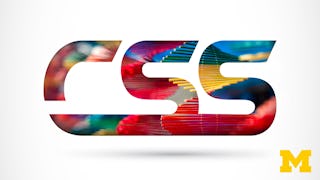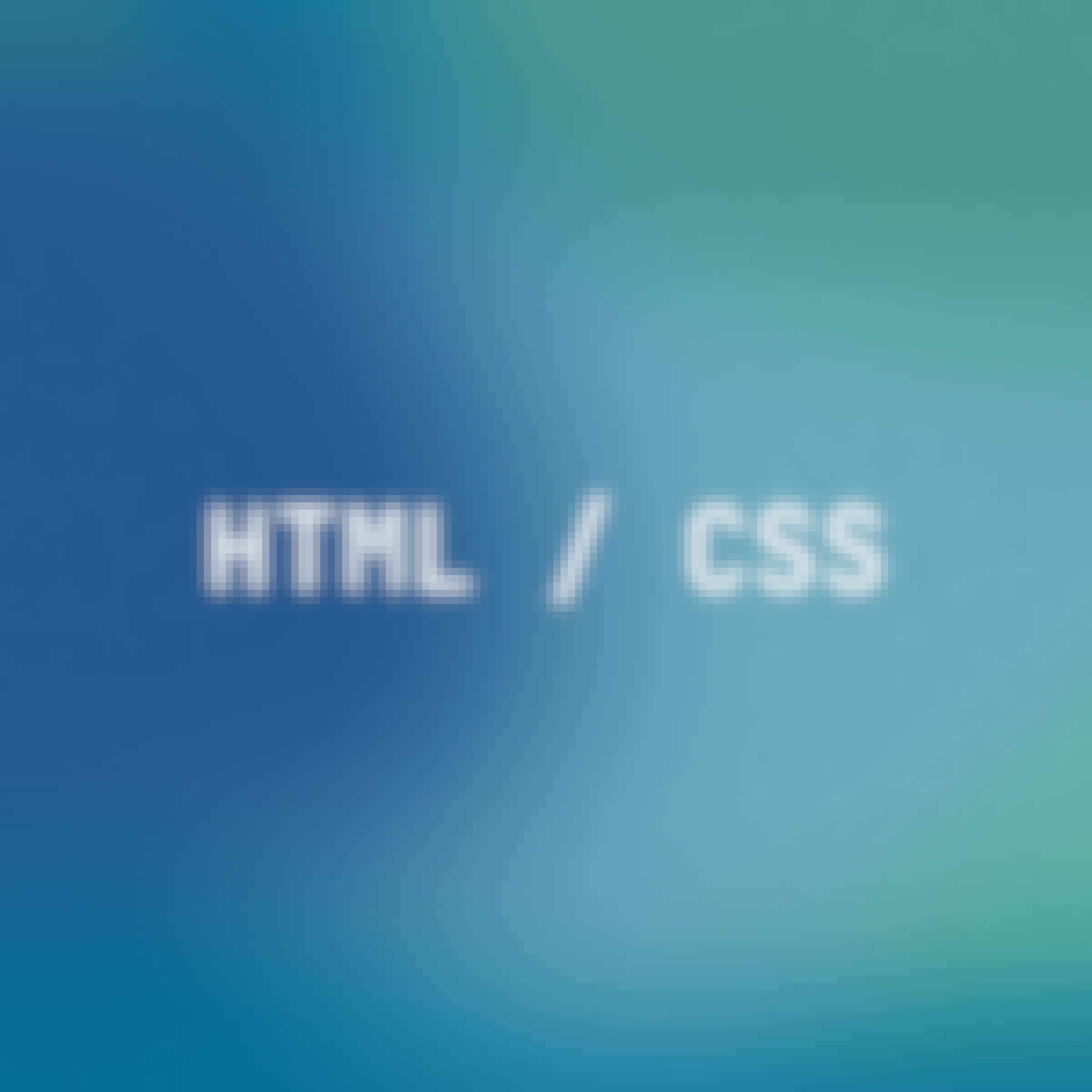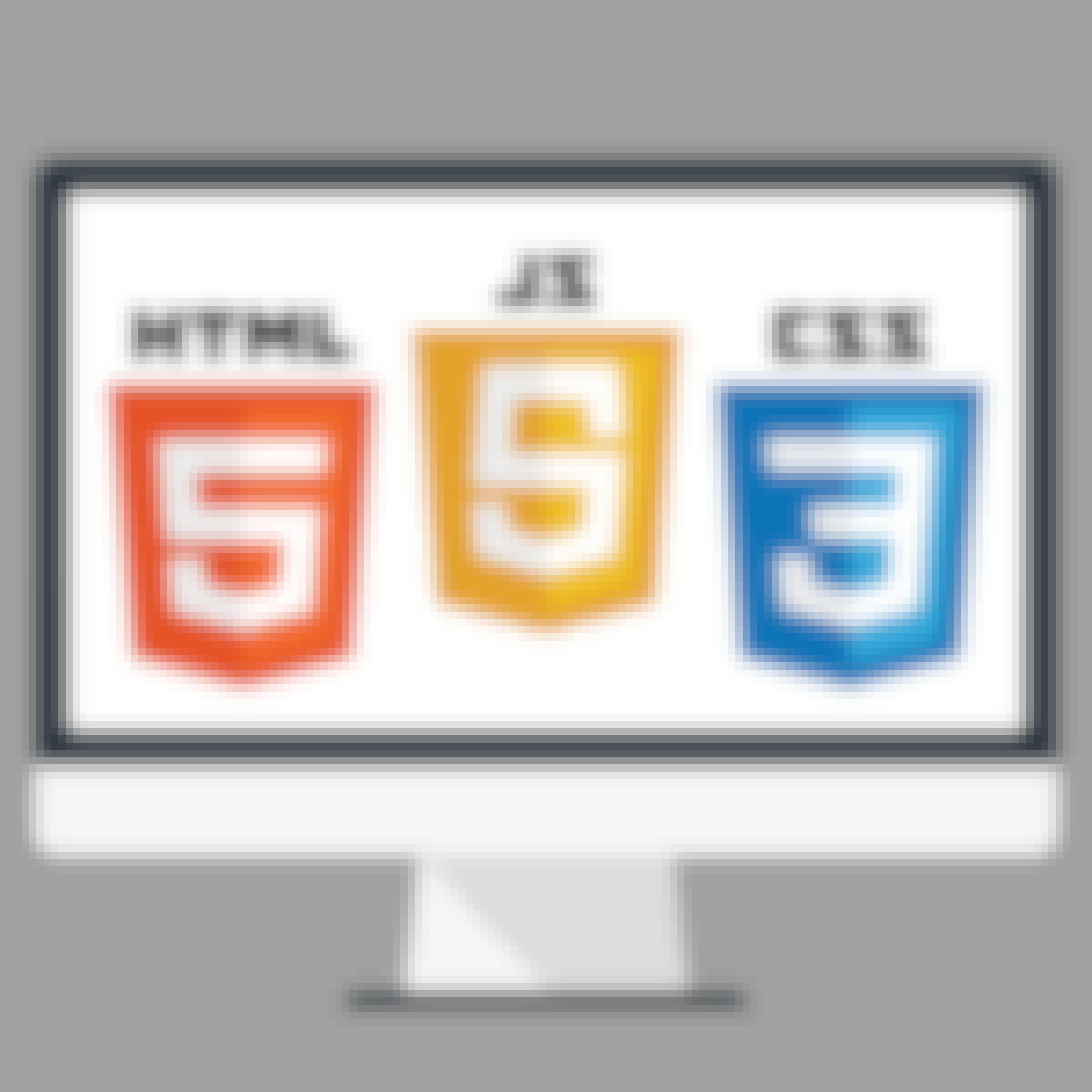- Browse
- Css
CSS Courses Online
Master CSS (Cascading Style Sheets) for designing and styling web pages. Learn to create responsive and visually appealing websites.
Explore the CSS Course Catalog
 Status: Free TrialFree Trial
Status: Free TrialFree TrialSkills you'll gain: Responsive Web Design, Cascading Style Sheets (CSS), Web Development, Javascript, Bootstrap (Front-End Framework), Scripting, Browser Compatibility, Application Programming Interface (API), Back-End Web Development
4.4·Rating, 4.4 out of 5 stars668 reviewsBeginner · Course · 1 - 4 Weeks
 Status: Free TrialFree Trial
Status: Free TrialFree TrialSkills you'll gain: Responsive Web Design, HTML and CSS, Bootstrap (Front-End Framework), Debugging, UI Components, Front-End Web Development, Web Design, Semantic Web, Browser Compatibility, Web Development, Web Content Accessibility Guidelines, Web Analytics and SEO, Development Testing, Data Validation, Javascript, Animations
4.7·Rating, 4.7 out of 5 stars1.9K reviewsBeginner · Course · 1 - 4 Weeks
 Status: NewNewStatus: Free TrialFree Trial
Status: NewNewStatus: Free TrialFree TrialSkills you'll gain: Cascading Style Sheets (CSS), Responsive Web Design, HTML and CSS, LESS, UI Components, Web Design, Bootstrap (Front-End Framework), Web Design and Development, Front-End Web Development, User Interface (UI), Web Content Accessibility Guidelines, Typography, Hypertext Markup Language (HTML), Interactive Design, Web Development, User Interface (UI) Design, Animations, Information Architecture, Browser Compatibility, Web Analytics and SEO
Beginner · Specialization · 3 - 6 Months
 Status: Free TrialFree TrialS
Status: Free TrialFree TrialSScrimba
Skills you'll gain: Responsive Web Design, HTML and CSS, Hypertext Markup Language (HTML), Typography, Cascading Style Sheets (CSS), Web Design, Web Development Tools, Browser Compatibility, Application Deployment, Front-End Web Development, Web Design and Development, Web Development, Animations, Software Development Tools, UI Components, User Interface and User Experience (UI/UX) Design, Usability, Javascript, Maintainability, Interactive Design
4.6·Rating, 4.6 out of 5 stars219 reviewsBeginner · Specialization · 3 - 6 Months
 Status: Free TrialFree TrialJ
Status: Free TrialFree TrialJJohns Hopkins University
Skills you'll gain: Cascading Style Sheets (CSS), HTML and CSS, Javascript, Responsive Web Design, Ajax, Front-End Web Development, Bootstrap (Front-End Framework), Web Design, Hypertext Markup Language (HTML), Browser Compatibility, Web Design and Development, Web Development, JSON, Web Applications, Scripting, Usability, Cross Platform Development, Object Oriented Programming (OOP), Event-Driven Programming, User Interface and User Experience (UI/UX) Design
4.7·Rating, 4.7 out of 5 stars17K reviewsBeginner · Specialization · 1 - 3 Months
 Status: Free TrialFree TrialU
Status: Free TrialFree TrialUUniversity of Michigan
Skills you'll gain: Cascading Style Sheets (CSS), Web Content Accessibility Guidelines, HTML and CSS, Web Design, Hypertext Markup Language (HTML), Web Design and Development, Responsive Web Design, User Interface (UI), Web Development, Javascript, Debugging
4.8·Rating, 4.8 out of 5 stars9.6K reviewsBeginner · Course · 1 - 3 Months
What brings you to Coursera today?
 Status: Free TrialFree TrialS
Status: Free TrialFree TrialSScrimba
Skills you'll gain: Typography, Responsive Web Design, Cascading Style Sheets (CSS), HTML and CSS, Web Design, Front-End Web Development, UI Components, Web Development
4.5·Rating, 4.5 out of 5 stars37 reviewsIntermediate · Course · 1 - 4 Weeks
 Status: Free TrialFree TrialS
Status: Free TrialFree TrialSScrimba
Skills you'll gain: Typography, Responsive Web Design, Cascading Style Sheets (CSS), HTML and CSS, UI Components, Web Design, Web Design and Development, Front-End Web Development, Mockups, User Interface (UI), Web Development, Debugging
4.6·Rating, 4.6 out of 5 stars46 reviewsIntermediate · Specialization · 1 - 3 Months
 Status: Free TrialFree Trial
Status: Free TrialFree TrialSkills you'll gain: HTML and CSS, Bootstrap (Front-End Framework), Responsive Web Design, Front-End Web Development, User Interface (UI), JavaScript Frameworks, Web Design and Development, Web Applications, Web Development Tools, React.js, General Networking
4.8·Rating, 4.8 out of 5 stars13K reviewsBeginner · Course · 1 - 4 Weeks
 Status: PreviewPreviewS
Status: PreviewPreviewSScrimba
Skills you'll gain: HTML and CSS, Responsive Web Design, Cascading Style Sheets (CSS), Hypertext Markup Language (HTML), File Management, Web Design, Front-End Web Development, Web Development
4.8·Rating, 4.8 out of 5 stars61 reviewsBeginner · Course · 1 - 4 Weeks
 Status: Free TrialFree TrialJ
Status: Free TrialFree TrialJJohns Hopkins University
Skills you'll gain: HTML and CSS, Javascript, Responsive Web Design, Ajax, Front-End Web Development, Web Design, Web Applications, Hypertext Markup Language (HTML), Browser Compatibility, Web Development, Cascading Style Sheets (CSS), Usability, Cross Platform Development
4.7·Rating, 4.7 out of 5 stars17K reviewsMixed · Course · 1 - 4 Weeks
 Status: Free TrialFree TrialS
Status: Free TrialFree TrialSScrimba
Skills you'll gain: Responsive Web Design, HTML and CSS, Typography, Cascading Style Sheets (CSS), UI Components, Web Design, User Interface (UI) Design, User Interface and User Experience (UI/UX) Design, Browser Compatibility, User Interface (UI), Usability, Interaction Design, Hypertext Markup Language (HTML), Web Design and Development, Web Content Accessibility Guidelines, Animations, Front-End Web Development, Web Development, Web Development Tools
4.8·Rating, 4.8 out of 5 stars8 reviewsIntermediate · Specialization · 1 - 3 Months
In summary, here are 10 of our most popular CSS courses
- Introduction to HTML, CSS, & JavaScript: IBM
- HTML and CSS in depth: Meta
- CSS Mastery: Responsive Design & Web Styling: EDUCBA
- CSS: Scrimba
- HTML, CSS, and Javascript for Web Developers: Johns Hopkins University
- Introduction to CSS3: University of Michigan
- Learn Tailwind CSS: Scrimba
- Tailwind CSS: Scrimba
- Introduction to Front-End Development: Meta
- HTML & CSS Crash Course: Scrimba
Frequently Asked Questions about Css
Cascading Style Sheets (CSS) are sets of instructions for how different parts of web pages should be displayed for users. In contrast to HTML, which defines the elements that structure a web page including headlines, paragraphs, images, and links, CSS defines the “style” of how these elements look, including layouts, colors, fonts, and other aspects. Because the web is inherently a visual medium, a mastery of CSS is an important part of designing an impactful web page.
User expectations for web design and thus CSS have come a long way since the 1990s, with the need to ensure that pages display properly on a variety of mobile devices as well as web browsers. There is also a growing recognition that web accessibility for users with disabilities must be a design priority, adding complexity to CSS considerations. The use of CSS frameworks such as Bootstrap has become increasingly popular to simplify the process of making responsive web designs that adjust to different browsers and user needs.
Along with HTML and JavaScript, expertise in CSS is one of the most fundamental skills you need for a career in web development. Demand for web developers to design and build websites has grown steadily along with the growth of the World Wide Web itself, and having high-level CSS skills and a sharp design sense can make your portfolio stand out from the crowd. According to the Bureau of Labor Statistics (BLS), web developers earned a median annual salary of $73,760 in 2019 and jobs in this field expected to grow “much faster than average,” making this a well-paid and high-growth career path.
Absolutely! Learning on Coursera is a popular way to build a wide range of web development skills, including CSS as well as the use of CSS frameworks like Bootstrap. You can take courses and Specializations spanning multiple courses from top-ranked schools like Johns Hopkins University, University of Michigan, and Duke University. With the Coursera Project Network, you can also develop your CSS skills by completing step-by-step tutorials alongside experienced instructors with Guided Projects.
A skill you will need to already have before learning CSS is the ability to code in the HTML language. You may also want to have some basic knowledge of what CSS does aesthetically for a website, such as specifying its style, page layouts, colors, and fonts.
Learning CSS may be right for you if you want to design complex layouts with unique fonts and customized color schemes. If you want to learn how to write CSS rules and how to test code so that the site you design works for people of all cognitive and physical abilities, learning CSS may be right for you.
A common career path for someone who knows CSS, as well as HTML, is to begin as a junior or entry-level web developer by building simple static websites, coding email templates, and working with experienced developers on larger projects as you hone your skills. As you learn more about CSS and other tech skills you can enter common career paths in front-end development, back-end development, web design, visual design, and digital marketing. Knowing CSS may also be helpful if you choose to enter a career path as a digital content editor or producer or manage social media client accounts. Other common career paths you can find with a background in CSS might be a WordPress developer or webmaster.
There are many topics related to CSS that you can study, including learning JavaScript and other scripting languages for web page interactivity, DOM to be able to modify pages, and responsive web design so that a site can be seen and accessed on various devices. You might also want to study the related topic of the Django web framework and Django template language so you can incorporate that into your web designs.
Even if you only know the fundamental skills of CSS and HTML, some places will hire you with that background, such as a restaurant that may hire you to create a static online menu. A local business can hire you to build some sales pages or a landing page, and a business might need your skills to create email templates for platforms such as Mailchimp. A business or company may need to hire someone with your background in CSS to customize a WordPress or Squarespace site, keep a blog maintained, or create simple online marketing campaigns.
Online CSS courses offer a convenient and flexible way to enhance your knowledge or learn new CSS skills. Choose from a wide range of CSS courses offered by top universities and industry leaders tailored to various skill levels.
When looking to enhance your workforce's skills in CSS, it's crucial to select a course that aligns with their current abilities and learning objectives. Our Skills Dashboard is an invaluable tool for identifying skill gaps and choosing the most appropriate course for effective upskilling. For a comprehensive understanding of how our courses can benefit your employees, explore the enterprise solutions we offer. Discover more about our tailored programs at Coursera for Business here.
Advanced CSS animation involves creating smooth, responsive transitions and interactive effects using keyframes, transforms, and timing functions. It’s used to enhance user experience in modern web design. Courses like Web Design for Everybody from the University of Michigan on Coursera include lessons on creating advanced animations with CSS.










